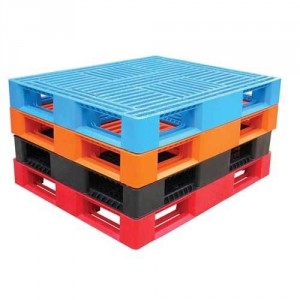 In the 1967 film “The Graduate”, the lead character Benjamin, played by Dustin Hoffman, is given some memorable career advice by an older businessman.
In the 1967 film “The Graduate”, the lead character Benjamin, played by Dustin Hoffman, is given some memorable career advice by an older businessman.
“I just want to say one word to you,” the man tells the confused Benjamin. “Plastics.”
Perhaps the pallet industry is taking that advice to heart. Today, plastic pallets represent the fastest growing segment of pallets use worldwide. They are light, more durable and less expensive to produce than the two other materials commonly used: Wood and steel.
Plastic vs. Wood and Metal
Wood pallets are the traditional material used for building pallets and many pallets made of wood are still being used today. But wood can splinter, is more prone to rot and decay, and is much heavier than plastic. Wood pallets usually are made in only a handful of sizes, so users are forced to build their loads according to the pallet’s specifications, not their own unique needs.
Metal pallets provide stability, but are exceedingly heavy and are the most costly type of pallets to produce. They are primarily only used in aviation for airdrops or for the shipment of extremely heavy loads.
Plastic pallets, however, offer both versatility and affordability and are widely used in food and beverage, agriculture, electronics, textiles, pharmaceuticals and a variety of other industries.
Plastic Can Be Formed into Any Shape
One of the biggest benefits of plastic pallets is that they can be formed using the injected molding process into any desired shape. That means that the end user can dictate the shape of the pallet to fit the load, rather than the other way around. They can be nested so that they take up less storage space than traditional wooden pallets.
Plastic pallets are also highly durable, are easy to keep clean, can be washed either by hand, with power washers or with industrial pallet-washing equipment.
Structural foam plastic pallets usually come in two common materials: Polyethylene and ploypropylene.
Polyethylene is a less expensive material, but polypropylene tends to be more crack resistant and hold up better if it is dropped or makes an impact with a forklift.
Besides structural foam molding, other processes used to create plastic pallets include high pressure injection molding, thermoforming, compression molding, rotational molding and profile extrusion.
Innovations in Plastic Pallets
While plastic pallets have been in use in the US since just after the Second World War, they didn’t really evolve much until the invention of the Fast Lock Pallet, which allows users to create pallets in whatever custom size they need instantly.
Barhns offers a full line of plastic pallets and pallet accessories to meet your business’s shipping and warehousing needs, including structural foam plastic pallets. Check out our complete inventory and you will find the perfect plastic pallet to improve your operations and increase profitability.
